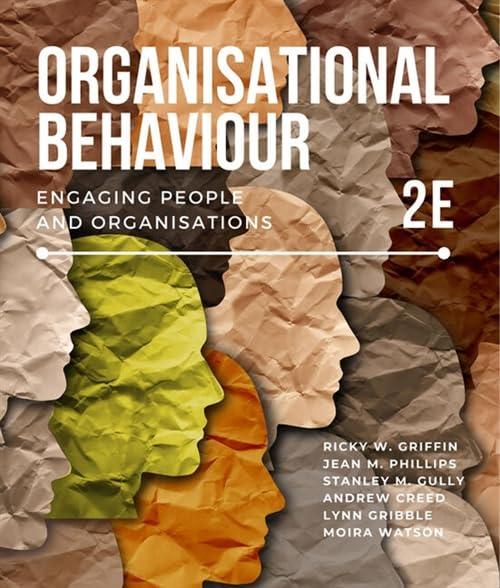Professor Mary McGregor was troubled as she walked towards the deans office. She was not looking forward
Question:
Professor Mary McGregor was troubled as she walked towards the dean’s office. She was not looking forward to combating yet another push for her organisational behaviour and management unit to follow the university’s move towards large lecture-style classes. As she walked up the stairs she thought about how she would frame her argument that the nature of this unit required class sizes of around 25, not 250, and definitely not the 500 that was being promoted in some disciplines. Whether she was conducting classes online, face-to-face or hybrid, Mary focused on developing well-rounded individuals able to ask questions, challenge opinions, propose views and engage collaboratively with difficult ideas. She considered it important that students participate actively in their learning and that they exit from her unit able to apply their knowledge in a range of contexts in a globalised world. Mary had made adjustments to her material to accommodate online requirements but did not think it was possible to achieve these aims via a mass dump of information with no opportunity for students to reflectively consider the practice implications in pairs and small groups. Mary knew that the basis of the large classes was rationalisation. Argued as a need to increase efficiency, the university was seeking more control and greater predictability and calculability over the academic process.
With an aim to increase profits, the university was shifting to a mass approach using an information transmission model of education where the interaction between the lecturer and the students was very limited. Essentially a monologue by the lecturer, the students were passive recipients of the material conveyed. Knowledge comprised encoded information transmitted from the mouth of the lecturer and tipped into the brains of the students. The truncated lecture notes taken so diligently by the student, to different degrees of competence, decoded the lecturer’s message and became the storehouse of this information. As a further example of rationalisation, the university sought to ensure this message was transmitted to the largest audience by recording the lectures for students not present at the class.This conduit model of education did not fit with Mary’s conception of university as a place where learning was a vigorous and dynamic process of dialogue between professors and students about possibilities with a range of interpretations. She did not think that knowledge could be reduced to the transmission of immutable facts. She believed that knowledge was co-produced in a disputed, context-dependent, continually changing process. Mary considered the passive consumer approach promoted by the conduit model focused more on information handling and recitation than critiquing the reality and considering alternatives. Mary was concerned that the university was pushing towards greater corporate colonisation. Although the rhetoric was about having students at the centre and providing them with greater access at times convenient to them, Mary wondered if it was more about the university gaining greater control over producing graduates with marketable skills. More and more, Mary was seeing a push away from the university offering education that developed critically aware citizens towards the training of unquestioning workers for jobs in the corporate world. Education was being presented as a product to be consumed rather than a process in which to engage. It was being expected that all the knowledge be prepackaged in textbooks, which were seen as commodities to be disposed of at the end of a semester. The importance of gaining the degree by any means had seen an increase in plagiarism and cheating as students sought to gain higher grades that would make them more employable.
Approaching the dean’s receptionist, Mary finalised the points she would make to the dean in communicating the importance of retaining her current class size and continuing her practice of enabling students to reflectively engage with the discipline.
Questions Mainstream
1. In what ways are the university’s move towards large lecture-style classes similar to or different from the process of communication presented at the beginning of this chapter?
2. What might be some communication barriers in the conduit model of the large lecture-style classes that could interfere with accurate communication of the lecturer’s message?
Critical
1. How does the proposed change to Mary’s OBM class fit the process of rationalisation?
2. In what ways is the university’s approach an example of corporate colonisation?
Step by Step Answer:

Organisational Behaviour Engaging People And Organisations
ISBN: 272389
2nd Edition
Authors: Ricky W. Griffin, Jean M. Phillips, Stanley M. Gully, Andrew Creed, Lynn Gribble, Moira Watson





